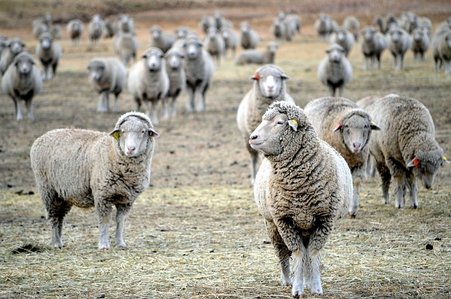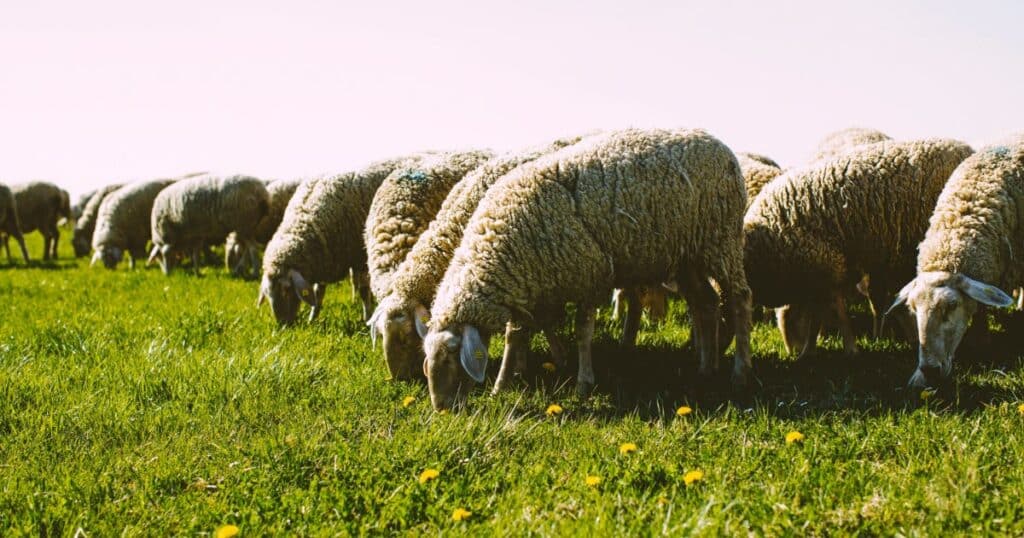One of the most common questions asked by both new and experienced shepherds is “How Many Sheep Per Acre of Pasture is Ideal?”. While there are good numbers to base your sheep stocking rate decisions on (and we’ll include those in this article), the short answer is that the sheep space requirements in your flock depends on several factors.
The unique grasses available in your pasture, and the climate your farm is located in are important factors which determine how many sheep per acre of pasture will be ideal for your flock.
It’s also true that farms with more grassland available to their sheep, can enjoy longer grazing periods. This is done by planting a variety of forages. This allows some acres to feature grasses which grow rapidly in spring. Others will grow late into the fall and winter.
This allows shepherds to graze more sheep per acre of pasture year round.
Get Your FREE Rotational Grazing Guide
This 16-page PDF is packed with our best information and tips to start increasing forage quality 30-70% in your pasture.
- Discover the science behind rotational grazing.
- Learn how you can improve forage quality and quantity.
- Discover creative ways you can manage your grasslands.
- Get helpful tips that can help you cut feed costs for your flock.
- Understand the trade-offs in switching to rotational grazing.
Sheep Stocking Rates Per Acre

There is no one sheep stocking rate per acre which is considered ideal for all climates and pasture conditions. But, a good rule of thumb is 10 ewes and 15 lambs per acre of pasture.
This assumes that you will be using a well-executed rotational grazing regimen.
Rotational grazing allows your sheep to graze and fertilize each paddock well. You then move them to new grasses before they have the opportunity to over-graze and damage the roots of the forages in your fields.
Sheep Per Acre for Rotational Grazing
Purdue University recommends the following pasture program for a 100-ewe flock of sheep. They state that if you properly manage and fertilize your pasture, 30 acres should be sufficient to supply a flock of 100 ewes and 150 lambs each year.
The shepherd would have to produce concentrates (shelled corn, grains) elsewhere – either on additional acreage or by purchasing this feed.
TIP: You can easily sub-divide pastures with temporary, electric sheep netting. Read more about electric sheep netting here >
Purdue recommends that rotational grazing on a combination of seasonal pasture and year-round pasture works best in most climates. They suggest subdividing the 30 acres into three 10 acre fields.
Each field has a suggested sheep stocking rate of 10 ewes and 15 lambs per acre. You would divide each of these three fields into paddocks and managed as follows:
Field A: Temporary Pasture Crops

The 10 acres used for this section of your sheep pasture will be planted, plowed, and re-planted with temporary, seasonal crops throughout the year. Purdue recommends the following crops for temporary grazing for sheep:
Recommended Management:
- Plow and seed to winter wheat in late August
- Graze as breeding pasture in late-fall for spring-lambing ewes, or as a lactation pasture for fall-lambing ewes.
- Rest pasture until April
- Graze in April and May as lactation pasture for spring-lambing ewes, or a breeding pasture for fall-lambing ewes.
- Plow in late May, seeding to sudangrass in 14-inch rows.
- Graze in June/July with spring-born lambs.
Field B: Permanent Pasture

The 10 acres designated as “permanent pasture” will have a combination of mixed grasses and legumes and can be used for grazing year-round, or for harvesting forages to store as hay.
Recommended Management:
- Harvest early spring growth for storage (hay, haylage, silage) in late May or early June.
- Allow sheep to graze regrowth with non-lactating spring-lambing ewes and/or pregnant fall-lambing ewes during July and August.
- Use Field B as an “emergency” grazing pasture when Field A and Field C do not provide adequate forages for your flock. This can be done throughout the year, as needed.
Field C: Tall Fescue for Winter

The winter forages pasture will be seeded with tall fescue grasses, can be harvested for hay in May (or grazed by ewes and lambs), a second crop will be harvested in late summer, and late fall grazing is also available here.
Recommended Management:
- Harvest early growth for storage as hay, or graze ewes and lambs on this early growth during May and June.
- Harvest the second growth in July and August, stacking in barn, or storing as round bales in t he field.
- Delay fall grazing of this pasture until the end of your grazing season (late fall – early December).
- If climate allows, graze Field C from December through April 1, supplementing with stored round bales or stacked bales as needed.
Here’s an image from the Agriculture Department at Purdue University, which covers the different types of grasses and crops you can plant your acreage with to take advantage of the rotational grazing plan outlined above:

Other Considerations About Sheep Space Requirements
In addition to your climate and the quality of forages available on your pasture, other considerations you should make when determining the ideal number of sheep per acre of pasture on your farm are:
The Size of Sheep in your Flock
Smaller sheep will typically consume less forage, so you may be able to graze more sheep per acre of pasture.
The Daily Grazing Period
Sheep in cooler climates will typically graze later into the morning, and earlier in the afternoons, whereas sheep flocks in extreme heat will seek shelter and shade during the day, grazing for fewer hours.

The Terrain in your Pastures
If you have smooth, flat pastureland with access to fresh water available in numerous places, your sheep may graze more efficiently than they would on rough, hilly terrain with access to water in only one location.
Deciding How Many Sheep Per Acre of Pasture is Right for You
Most shepherds with modest-sized flocks will determine their ideal sheep space requirements on pasture by experimenting with several different pasture management strategies.
Regardless of how many acres you have, it’s best to sub-divide that acreage into small, manageable paddocks, allowing sheep to graze each paddock well before shifting them over to fresh grasses, and allowing the grazed pasture to re-grow.

Not only will taking this approach allow the most nutrient-dense grasses on your farm the opportunity to flourish, you can also cut down on internal parasites affecting your flock, by allowing them to die in the field before returning stock to that pasture.
My advice is to start with 10 adult ewes and 10-15 lambs per acre of pasture, and to see how this works for your farm. If you have a 3 acre pasture, section it off into 6 half-acre paddocks using temporary sheep fencing, allowing your flock to graze each half-acre for 5 days or so before moving them to the next.
This will give you about a month of active grazing time on healthy grasses for your flock. This, in turn, delivers a month of re-growth time for each paddock before sheep return to it.
Final Thoughts on Determining How Many Sheep per Acre of Pasture is Appropriate on Your Farm
The key to a successful grazing program is to pay attention to the land on your farm. That will determine how many sheep per acre of pasture is ideal for your farm and flock.
Whether you have year round grazing available, or you have to supplement with stored forages (hay), and concentrates (grain), the amount of land and the quality of the forages you have available will determine the correct sheep stocking rates per acre of pasture at your farm.

Remember: overgrazing can destroy your pasture, so if you do not have enough grass for your sheep, take them off pasture completely to give your grasses the opportunity to re-grow, feeding your sheep hay in the interim. This will allow your pasture to continue to produce and feed your flock, rather than allowing your sheep’s hooves to destroy the exposed root system of vital grasses.


